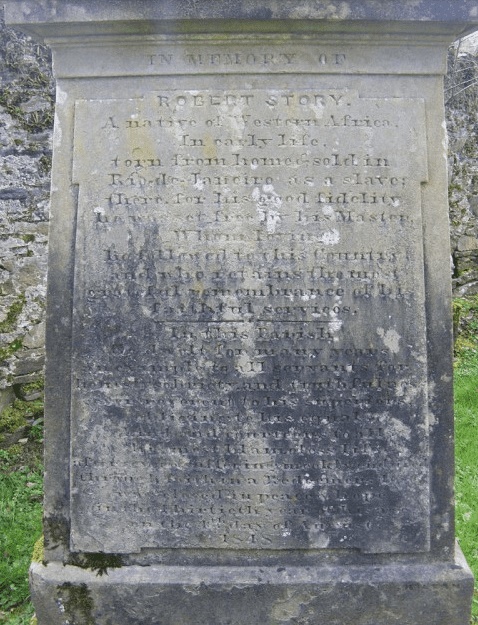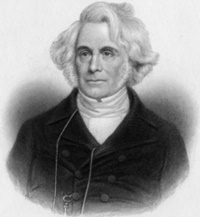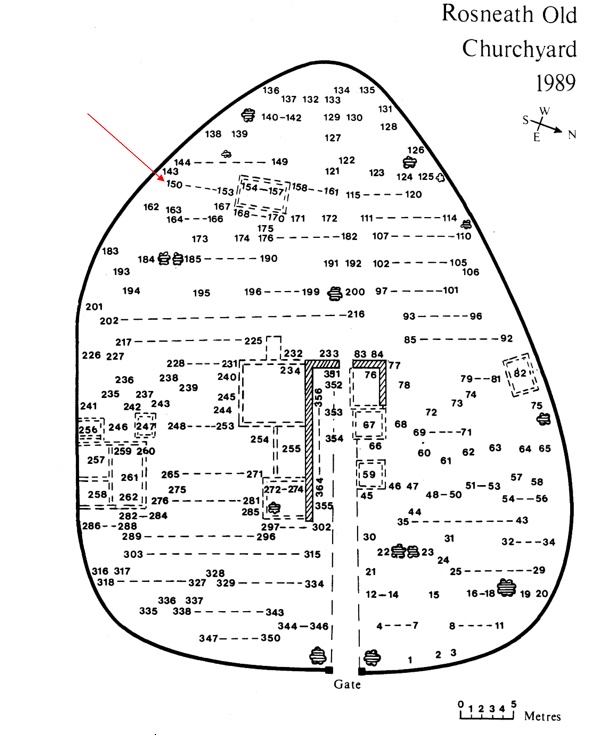
Robert Story – Emancipated Slave – Rosneath Graveyard
In the South-West corner of the old Rosneath Parish Graveyard, lies the grand, and much eroded sandstone gravestone to an honest and true member of this community. The gravestone has become more difficult to read over the years, but the account of the life of one of the few emancipated African slaves in Scotland has long been appreciated by the Rosneath community.
The gravestone bears the name of former slave Robert Story, a name which we know was not that originally given to him when he was abducted from Africa, then landed at and sold at Valongo Wharf, the slave market of Rio di Janeiro. His original name, known only to himself, was lost in the tragedy of slavery, but the need to belong was strong in this man when he chose Christian Baptism and adopted the name of his new employer, the Reverend Robert Story, minister of the then Rosneath Free Church.
The emancipated slave was brought to Rosneath by a good friend of the Rev. Story, Stewart Kerr from Kelso, the same town of birth as the Rev. Story. Stewart Kerr had returned from Trinidad with a man servant he had brought out of slavery, giving him good work and a fair wage.
With the Blockade of Africa in 1808, the British outlawed the Atlantic slave trade and it became illegal for British ships to transport slaves. The Royal Navy established a presence off Africa to enforce the ban on all ships between Africa and the Americas. However the background to the abolition of slavery, prior to (and after) this new chapter of Robert Story’s life in Rosneath, was strong in Scotland with the resistance to slavery through the Scottish abolitionist movement. It is hard to say from the writings and references provided, as to whether the African played any part of that movement through the Reverend Story’s actions, but sadly many Scottish industries, schools and churches were founded from the profits of African slavery. It was also hard to imagine that even Robert Burns the friend of humanity, enemy of injustice and oppression, was considering a position as a book-keeper in a plantation before poetry revived his fortunes. In 1796, Scots owned nearly 30 per cent of the estates in Jamaica and by 1817, a staggering 32 per cent of the slaves. However, complete abolition of slavery did not come until the Slavery Abolition Act 1833. The Glasgow Anti-Slavery Society was formed in 1822 and the city was known as one of the staunchest abolitionist cities in Britain, with William Wilberforce being heavily supported by Scots James Ramsay and Zachary Macaulay of Inveraray. Macaulay was repulsed by what he saw while working as an overseer in a West Indies plantation. He founded the Anti-Slavery Reporter and eventually became governor of Sierra Leone, a colony founded by freed slaves.
Once the African, Robert Story was adopted, he lived and worked at the Rosneath Manse, and throughout the community, where he continued to work for several years. We know that Robert Story was treated fairly and considered in high regard by the community, as a free man and devout Christian for many years after his passing.

Some 55 years after the death of Robert Story, Rosneath Historian, W. C., Maughan, writing in Rosneath Past and Present, repeated the words of tribute provided by the “Old Story” (Rev. Story) to his African friend, writing the following: –
Robert Story, the emancipated African Slave died peacefully at the end of 1848 at the age of 30 and was buried solemnly in airy and bright part of the graveyard. The Revered Story granted his old friend a larger and more impressive headstone than he himself would be given some eleven years later. To die at such a young age was a tragedy. It is clear however that African’s life had been difficult from the start, exposed to the terrors of life that few of us could image. We trust in later life he gained the love and peace that he deserved in our dear community.
A number of years ago, the then minister of Rosneath Parish Church, at the time the headstone was assessed, the Rev T. Forrest Smith, said:-
“The Rev. Robert Story was 150 years ahead of his time. He achieved what people are now only beginning to in this country, an acceptance of colour, he placed the slave’s grave inside a white man’s graveyard, which was a great honour for a coloured man in those times. The stone is one of the most impressive in the graveyard.”
With the support of Rosneath & Clynder Community Council and Dumbarton District Council, the headstone of Robert Story was catalogued and cleaned by the community project undertaken by the Civil Service Retirement Fellowship in 1987-1989. This was led through the excellent efforts of John Read (Jack) and Harold (Harry) Smallbone, assisted by many other distinguished members of the Rosneath Community.
Listed in the Survey as Grave 150, the Graveyard survey contains the photographic plate and inscription taken at the time of that project.
Grave 150 – Old Rosneath Graveyard
Details from that survey at the link below indicate where in the old Rosneath graveyard, Robert Story’s gravestone may be found.

http://web.archive.org/web/20130127131021/http:/members.madasafish.com/~fairenough/index.html
Further reading is available at the links below
Helensburgh Advertiser – Eye on Millig: Zachary Macaulay and his fight against slavery
Donald Fullarton – Helensburgh Heritage – The slave’s grave
